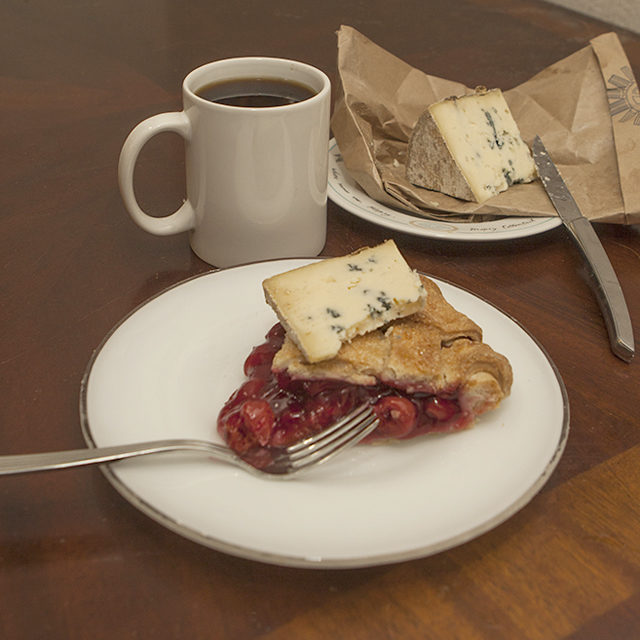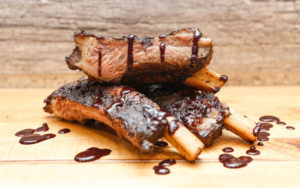
It is cherry season, and while everyone else is feasting on Colorado bing cherries, I’m hunting for Montmorency cherries, one of the best foods on the planet. Bing cherries are bred to be big, firm and super-sweet with a long shelf-life, but tart cherries are small, delicate and jammin’ with flavor and character.
When was the last time you saw fresh — not frozen, canned or dried — pie cherries for sale at a supermarket, farmers market or farm stand? Your answer would be “almost never.” If you see fresh Colorado tart cherries, buy them at any price. More likely a few cherry sellers at farmers markets will have frozen pie cherries, usually sold by the quart or gallon.
That is why few sights make me sadder than driving around Boulder County seeing “ornamental” Montmorency trees.
The precious, dark pink cherries hanging heavy on the trees could be nestling inside pastry or roast pork instead of falling to the ground or gurgling in the guts of ravenous squirrels and birds. It makes me want to hold a memorial service for the fallen fruit as a beautiful, well-cared-for tree is ignored at its greatest moment of the year. (You might as well chop it down — an activity George Washington never engaged in, making it the first known case of presidential fake news.)
I’ve had a thing for tart cherries since I was a kid. I remember getting in trouble for attacking a deep-dish cherry pie before a family event, but it was so damn good. Despite my bona fides as a national pie expert, I still have an excessive fondness for cherry Hostess Pies. I usually have a quart of tasty, anti-inflammatory tart cherry juice in my fridge to add to water and iced tea.
These wasted trees are also a tragedy because Colorado’s season is short, poignant and sometimes non-existent. I know from personal experience that cherry trees are damn hard to grow in the Front Range’s climate of extremes. When the trees were good, they were very, very good and produced copious quantities of fruit. When they were bad almost every other year, they produced a bumper crop of disappointment and nearly zero cherries. In good years, you have to guard the crop with your life and with fake birds of prey, nets, shiny hanging things and noise-makers.
Harvest is also a pain. Forget Pilates, Crossfit or stand-up paddleboarding for your next workout. Find a full cherry tree, bring a ladder and a bucket and prepare to sweat as you pick and stain your fingers pink. I guarantee you will never, ever again undervalue the laborers who harvest America’s cherries or the cost per pound.
Pitting cherries is an undeniably tedious process, especially when you discover how many tart cherries it takes to make a deep-dish cobbler. Some folks pit them by hand in a meditative practice, but if you are doing pounds of them you need a manual cherry pitter to speed up the process. Whatever you do, save the juice for drinking or cooking.
All the effort is more than worth it.
One of my family’s favorite Thanksgiving side dishes over the years has been pickled pie cherries. They are very easy to make and, while you can taste them after a few weeks, it’s best to let them age. Break the cherries out for a garnish in Manhattans, serve them with grilled fish or as a cranberry sauce alternative with turkey and stuffing.
Pickled Pie Cherries
1/2 cup rice, white or champagne vinegar
1/3 to 1/2 cup water
1 1/2 cups sugar
1/2 teaspoon salt
Additions: black peppercorns, fresh ginger, allspice, bay leaves, chile flakes, mustard seeds
1 1/2 pounds tart pie cherries, rinsed and pitted
Bring vinegar, water and sugar to a boil and continue until sugar is dissolved. Remove pan from heat and add any or all of the spice additions. Some cooks only use salt and peppercorns. Pack cherries into a heat-proof jar and fill to the top with liquid. Seal with a tight lid and refrigerate.
Note: Leftover liquid can be strained, reduced by simmering and served as a sauce over vanilla ice cream.
Cherry buying reminder: You’ll find Colorado dark cherries for sale at supermarkets in printed plastic standup bags with a zip top. Despite appearances, you don’t have to buy the whole bag. Just open a bag and transfer the amount of cherries you want into a produce bag.
Local food news
Learn to make your own cheese curds at Wine & Whey’s advanced cheddar class on June 24. The shop also has an upcoming class in making Port. wineandwhey.com. … The Custer County Cowboy Gathering August 19–20 in Westcliffe features Western music, cowboy poetry and a nationally sanctioned Chuck Wagon cook-off and tasting. custercountycowboygathering.com.
I’ll take a pea milk
There is a billboard across U.S. 36 from Broomfield’s 1stBank Center that advertises Ripple, a new dairy-free, vegan, nut-, lactose- and gluten-free milk alternative. Large letters trumpet it as “pea milk.”
It is childish but I predict that approximately 50 percent of the population, mainly men, will never knowingly buy or consume “pea milk.” Perhaps they should have labelled it “legume latte.”
Colorado’s farm-to-phone app
One of the best sources for finding the state’s incredible bounty is the Department of Agriculture’s free 2017 Colorado Farm Fresh Directory to more than 200 farms, ranches, roadside stands, u-picks, plus farmers markets, locally-focused restaurants, wineries, county fairs and agricultural festivals. It’s available in print, online at coloradoagriculture.com/farmfresh, and as a farm-to-phone mobile app. It’s a nice fashion accessory to your Fitbit.

Taste of the week
Impressive indeed are the mighty bison ribs at Tocabe, the metro area’s only fast casual eatery featuring Native American cuisine. The eateries in Denver and Greenwood Village are co-owned by a member of the Osage Nation. The bison ribs are slowly oven braised, fall-off-the-bone tender and finished on the grill to pick up some char. The bones are dished with a fluffy round of fry bread with house hot sauce and a berry barbecue sauce. They are worth a drive.
Words to chew on
“When we lose, I eat. When we win, I eat. I also eat when it’s rained out.” — Tommy Lasorda, former Los Angeles Dodgers manager
John Lehndorff hosts Radio Nibbles at 8:25 a.m. Thursdays on KGNU, 88.5 FM. Podcasts: news.kgnu.org/category/radio-nibbles.














